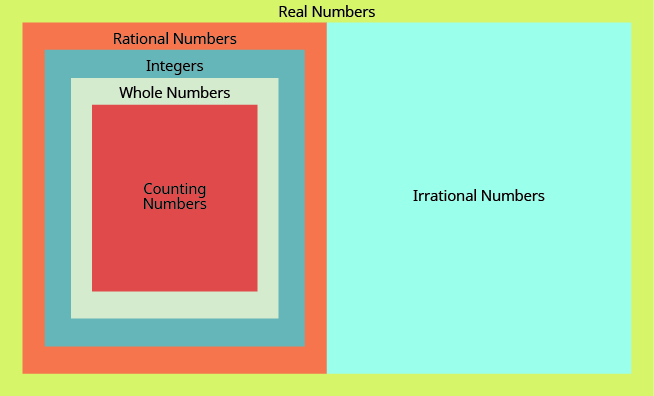- Categorize real numbers into counting, whole, rational, irrational, or integers
- Recognize and use the properties of real numbers
Defining and Identifying Real Numbers
We have seen that all counting numbers are whole numbers, all whole numbers are integers, and all integers are rational numbers. Irrational numbers are a separate category of their own. When we put together the rational numbers and the irrational numbers, we get the set of real numbers.
real numbers
Real numbers are numbers that are either rational or irrational.
This diagram illustrates the relationships between the different types of real numbers.

- Natural Numbers or Counting Numbers: Start with [latex]1[/latex] and continue. [latex]1,2,3,4,5…[/latex]
- Whole Numbers: Counting numbers plus zero. [latex]0,1,2,3,4,5…[/latex]
- Integers: Whole numbers and their negative counterparts.
- Rational Numbers: Numbers that can be written in the form [latex]{\Large\frac{a}{b}}[/latex], where [latex]a[/latex] and [latex]b[/latex] are integers and [latex]b\ne o[/latex]. In decimal form, the numbers terminate or repeat.
- Irrational Numbers: Numbers that can’t be expressed as a simple fraction. In decimal form, the numbers do not repeat or terminate.
Does the term “real numbers” seem strange to you? Are there any numbers that are not “real”, and, if so, what could they be?
For centuries, the only numbers people knew about were what we now call the real numbers. Then mathematicians discovered the set of imaginary numbers.
An imaginary number is a number that, when squared, has a negative result, typically expressed as a real number multiplied by the imaginary unit [latex]i[/latex], where [latex]i^2=−1[/latex]. We won’t discuss imaginary numbers in this section, but you may encounter them in other places in this course.
Determine whether each of the numbers in the following list is a
- whole number
- integer
- rational number
- irrational number
- real number